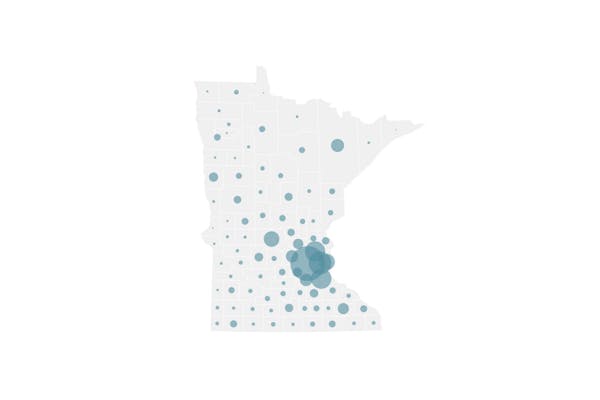The death toll from COVID-19 has reached 591 in Minnesota, where the continued spread of the infectious disease has caused 100 deaths every four to five days this month.
The Minnesota Department of Health on Monday morning reported 13 new deaths and 528 new lab-confirmed cases of COVID-19, which is caused by a novel coronavirus, bringing the statewide case count to 11,799. All but three Minnesota counties have confirmed cases, based on more than 115,000 molecular diagnostic tests by public and private labs.
As many as 80% of infections result in mild or no symptoms, and so far 7,536 Minnesotans with confirmed COVID-19 have recovered and are no longer required to isolate themselves to prevent from spreading the virus. There are 452 Minnesotans hospitalized for COVID-19, including 194 in intensive care due largely to severe respiratory symptoms and difficulty breathing.
The rising case and death counts come as Gov. Tim Walz must decide the next step in Minnesota's pandemic response. The governor has twice extended a stay-at-home order, which expires May 18, and has yet to announce what will happen after that.
The orders were largely designed to delay the peak of the pandemic and to buy time for hospitals to add critical care beds and ventilators. As of Monday morning, 1,024 of the state's 1,244 ICU beds were occupied by patients with COVID-19 or other medical conditions unrelated to the pandemic. Hospitals have another 1,351 ICU beds that could be readied within 72 hours. The state also has arranged for at least seven alternate care sites throughout the state — including a shuttered long-term care facility in Roseville — that could serve as overflow and provide hospital care for stable, non-COVID-19 patients.
The death and case figures reported Monday are lower than those reported in previous days. Counts on prior Mondays have been lower as well, though, due to less reporting of COVID-19 activity over the weekend.
Walz has granted more exemptions under the stay-at-home order, which originally took effect March 28, and allowed businesses deemed to be essential to continue. Two weeks ago, nonessential warehousing and manufacturing sites were allowed to reopen with social distancing plans in place to protect workers, and last week, retailers were allowed to do so as well to provide curbside and delivery service.
On Monday, hospitals were allowed to resume elective surgeries and procedures that had been temporarily banned to maintain supplies of masks and gowns for doctors and nurses treating COVID-19 patients.
Nearly 1,400 health care workers have suffered COVID-19, though only around 100 were deemed through investigations to likely have been infected on their jobs at hospitals, clinics or long-term care facilities.
Exactly how many workers returned to their jobs under these exemptions is unclear. The state Department of Employment and Economic Development had estimated as many as 100,000 manufacturers would restart work, based on estimates that 80% of those businesses would reopen. The state also estimated that 30,000 retail employees would return to work, assuming that businesses would only need 25% of their staff to provide curbside sales.
Walz has promoted a strategy after the stay-at-home order of aggressive diagnostic testing followed by contact investigations to find people who had been in close contact with COVID-19 cases.
A Minnesota House committee on Monday morning advanced a $300 million plan to use a staffing company to hire as many as 4,200 temporary workers to assist with the growing number of contact investigations. The bill would allow furloughed health care workers to be hired temporarily to conduct these investigations.
Staff writer Glenn Howatt contributed to this story.
Jeremy Olson • 612-673-7744
Twitter: @stribjo
8 months in jail for Blaine man who caused 120-mph crash hours after he was caught speeding

Daughter sues St. Paul, two officers in Yia Xiong's killing

